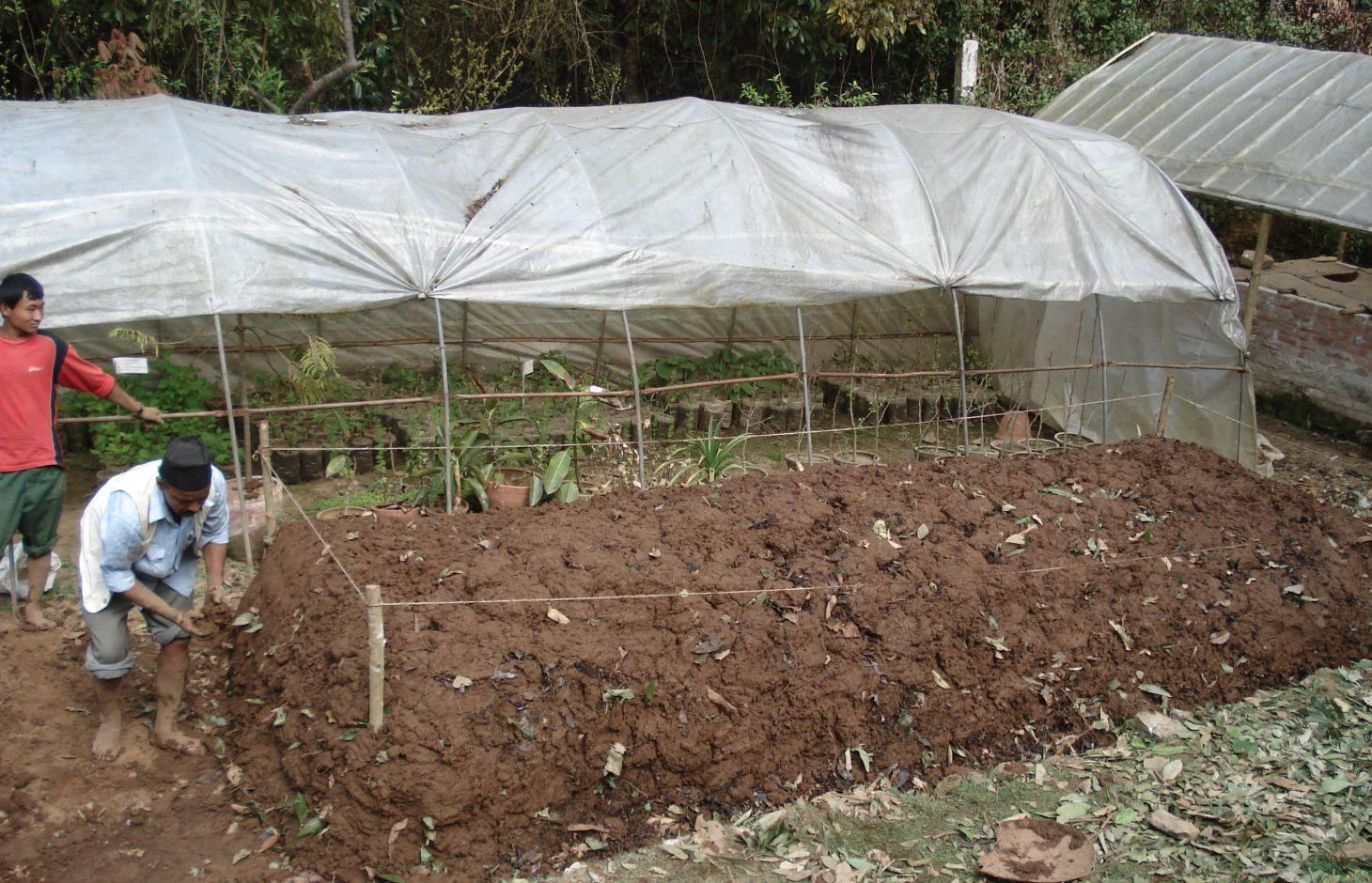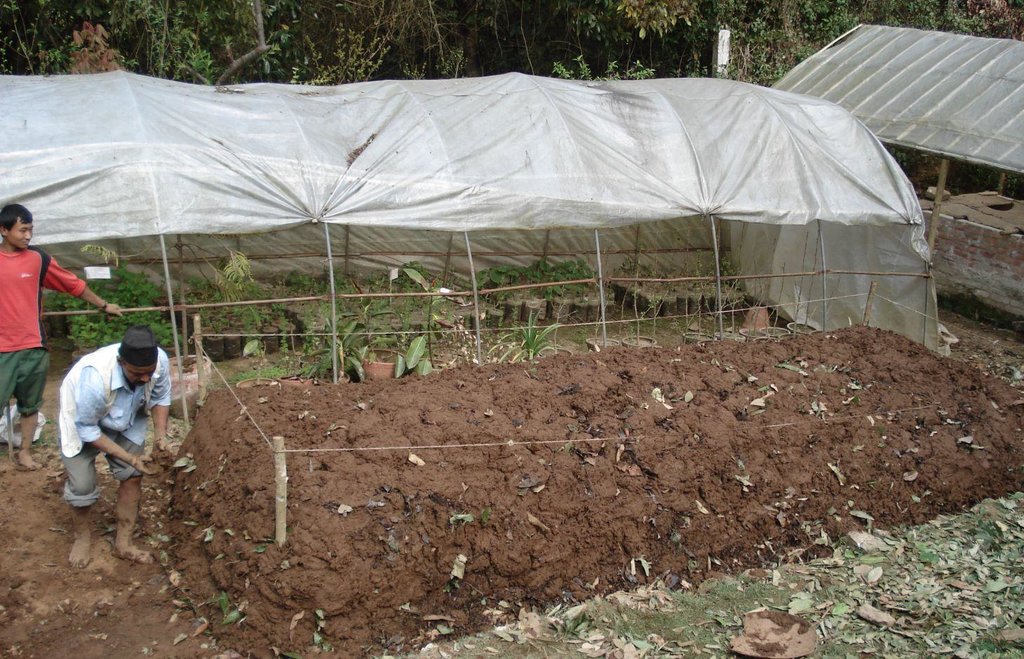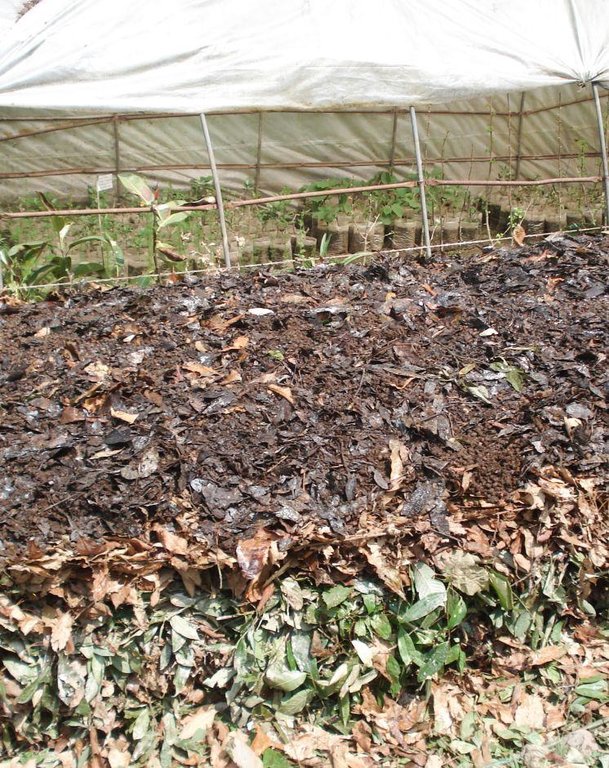Biodynamic composting [Nepal]
- Criação:
- Atualização:
- Compilador/a: Shreedip Sigdel
- Editor: –
- Revisores: David Streiff, Alexandra Gavilano
Jaibic Mal Banune Takika (Nepali) (Main Contributor: Samden Sherpa, ICIMOD)
technologies_1682 - Nepal
Veja as seções
Expandir tudo Recolher tudo1. Informação geral
1.2 Detalhes do contato das pessoas capacitadas e instituições envolvidas na avaliação e documentação da tecnologia
Especialista em GST:
Sherpa Samden L
ICIMOD
Nepal
Nome da(s) instituição(ões) que facilitou(ram) a documentação/ avaliação da Tecnologia (se relevante)
ICIMOD International Centre for Integrated Mountain Development (ICIMOD) - Nepal1.3 Condições em relação ao uso da informação documentada através de WOCAT
O/a compilador/a e a(s) pessoa(s) capacitada(s) aceitam as condições relativas ao uso de dados documentados através da WOCAT:
Sim
2. Descrição da tecnologia de GST
2.1 Descrição curta da tecnologia
Definição da tecnologia:
A faster and more effective way to produce high quality compost in large quantities by surface composting using dry and green farm biomass piled in a heap.
2.2 Descrição detalhada da tecnologia
Descrição:
Biodynamic denotes a method of organic farming that emphasizes a holistic understanding of the interrelationships between soil, plants, and animals in a self-sustaining system. It excludes the use of artificial chemicals and stresses the importance of integrating farm animals, the cultivation of crops, and caring for the land. Fermented herbal and mineral preparations are used as compost additives and field sprays.
Purpose of the Technology: Biodynamic composting is an inexpensive means of producing a large amount of compost within a relatively short time compared to other methods. It is ideal for farmers who require large amounts of compost, such as for orchards; or when several households get together to produce and share compost. This type of composting also helps to store soil carbon, assists irrigation practices that keep fields alternatively moist and dry, works to decrease the number of soil pests, and reduces methane emission. This practice not only enhances agricultural production as an on-site benefit to the land users but also contributes to the off-site benefits enjoyed by downstream land users, since it helps to reduce sedimentation and increases water availability.
Establishment / maintenance activities and inputs: The biodynamic compost is prepared as a surface heap rather than in a traditional pit. The heap is built on a flat, dry site away from shade trees and other elements that would promote water logging. The farmer marks out a rectangular plot of land according to his needs and places a set of logs or PVC pipes lengthwise in the middle of the rectangle to facilitate air circulation and help aerate the pile. Alternating layers of dry and green biomass are added on top. Rock phosphate and crushed slaked lime are added to the middle layers to enhance decomposition and to supplement the mineral content. Once the layering is complete, the pile is sealed using a paste made from soil and cow dung. Over the ensuing two months, the pile is watered weekly (through holes made in the plaster layer which are then resealed) and is monitored; any cracks that appear in the external plaster are sealed. At the end of this time, the compost is tested to check if it is ready by taking samples from a few different locations in the heap. When a crushed sample smells like forest soil, it indicates that the degradation is 80% complete and that the compost is ready to use.
2.3 Fotos da tecnologia
2.5 País/região/locais onde a tecnologia foi aplicada e que estão cobertos nesta avaliação
País:
Nepal
Especificação adicional de localização:
Lalitpur District
Especifique a difusão da tecnologia:
- Aplicado em pontos específicos/concentrado numa pequena área
Comentários:
Demonstration Plot at ICIMOD Knowledge Park
2.6 Data da implementação
Caso o ano exato seja desconhecido, indique a data aproximada:
- 10-50 anos atrás
2.7 Introdução da tecnologia
Especifique como a tecnologia foi introduzida:
- durante experiências/ pesquisa
3. Classificação da tecnologia de GST
3.1 Principal/principais finalidade(s) da tecnologia
- Reduz, previne, recupera a degradação do solo
- Access to fertilizer
3.2 Tipo(s) atualizado(s) de uso da terra onde a tecnologia foi aplicada

Terra de cultivo
- Cultura anual

Floresta/bosques
Produtos e serviços:
- Lenha
- fodder
Comentários:
Major land use problems (compiler’s opinion): Crop productivity is limited by poor soil fertility, intense cropping, and a scarcity of irrigation water. Farmers in the hills notice a marked decrease in the health of their crops and degraded soil conditions when chemical fertilizers are overused. Biodynamic composting is a low input response to this problem.
Forest products and services: fuelwood
Other forest products and services: fodder
Constraints of Scrubland
3.5 Grupo de GST ao qual pertence a tecnologia
- Gestão integrada de fertilidade do solo
3.6 Medidas de GST contendo a tecnologia

Medidas de gestão
- M5: Controle/mudança de composição de espécies
3.7 Principais tipos de degradação da terra abordados pela tecnologia

Deteriorização química do solo
- Cn: declínio de fertilidade e teor reduzido de matéria orgânica (não causado pela erosão)
3.8 Redução, prevenção ou recuperação da degradação do solo
Especifique o objetivo da tecnologia em relação a degradação da terra:
- Prevenir degradação do solo
4. Especificações técnicas, implementação de atividades, entradas e custos
4.1 Desenho técnico da tecnologia
Especificações técnicas (relacionada ao desenho técnico):
Layering of the different materials in a biodynamic compost heap
Technical knowledge required for field staff / advisors: moderate
Technical knowledge required for land users: moderate (technicians as well)
Main technical functions: increase in organic matter, Increase Soil fertility and Productivity, Improve Physical condition of the soil
Secondary technical functions: increase of infiltration, increase / maintain water stored in soil, Improve the physical properties of the soil
Other type of management: Improve Compost Quality
Autor:
Layering of the different materials in a biodynamic compost heap
4.2 Informação geral em relação ao cálculo de entradas e custos
Especifique como custos e entradas foram calculados:
- Por unidade de tecnologia
Especifique a unidade:
compost heap
Outro/moeda nacional (especifique):
NPR
Se for relevante, indique a taxa de câmbio do USD para moeda local (por exemplo, 1 USD = 79,9 Real): 1 USD =:
71,0
4.3 Atividades de implantação
| Atividade | Periodicidade (estação do ano) | |
|---|---|---|
| 1. | include cow dung, crushed lime, rock phosphate (or bone meal), and dry and green farm matter. The compost heap is assembled in less than one day and the compost is ready to use within two months (under weather and temperature conditions similar to those at the ICIMOD Knowledge Park).Note: If rock phosphate is not available, crushed stone dust can besubstituted. | 2 month |
4.4 Custos e entradas necessárias para a implantação
| Especifique a entrada | Unidade | Quantidade | Custos por unidade | Custos totais por entrada | % dos custos arcados pelos usuários da terra | |
|---|---|---|---|---|---|---|
| Mão-de-obra | Labour | unit | 1,0 | 80,0 | 80,0 | |
| Equipamento | Shovel, chopping machine, bucket, bamboo, rope | unit | 1,0 | 20,0 | 20,0 | |
| Material de construção | cow dung | kg/unit | 300,0 | 0,1 | 30,0 | |
| Material de construção | lime and rock phosphate | kg/unit | 25,0 | 0,8 | 20,0 | |
| Custos totais para a implantação da tecnologia | 150,0 | |||||
| Custos totais para o estabelecimento da Tecnologia em USD | 2,11 | |||||
4.5 Atividades recorrentes/manutenção
| Atividade | Periodicidade/frequência | |
|---|---|---|
| 1. | The compost heap is punctured weekly in order to add water; after watering, the punctures are resealed using cow dung. | weekly |
4.6 Custos e entradas necessárias pata a manutenção/atividades recorrentes (por ano)
| Especifique a entrada | Unidade | Quantidade | Custos por unidade | Custos totais por entrada | % dos custos arcados pelos usuários da terra | |
|---|---|---|---|---|---|---|
| Mão-de-obra | Labour | unit | 1,0 | 25,0 | 25,0 | |
| Material de construção | Compost / manure | unit | 1,0 | 10,0 | 10,0 | |
| Custos totais para a manutenção da tecnologia | 35,0 | |||||
| Custos totais de manutenção da Tecnologia em USD | 0,49 | |||||
4.7 Fatores mais importantes que afetam os custos
Descreva os fatores mais determinantes que afetam os custos:
All costs and amounts are rough estimates by the technicians and authors. Exchange rate USD 1 = NPR 71 in May 2011. This was a demonstration project conducted by ICIMOD.
5. Ambiente natural e humano
5.1 Clima
Precipitação pluviométrica anual
- <250 mm
- 251-500 mm
- 501-750 mm
- 751-1.000 mm
- 1.001-1.500 mm
- 1.501-2.000 mm
- 2.001-3.000 mm
- 3.001-4.000 mm
- > 4.000 mm
Zona agroclimática
- Subúmido
Thermal climate class: temperate
5.2 Topografia
Declividade média:
- Plano (0-2%)
- Suave ondulado (3-5%)
- Ondulado (6-10%)
- Moderadamente ondulado (11-15%)
- Forte ondulado (16-30%)
- Montanhoso (31-60%)
- Escarpado (>60%)
Formas de relevo:
- Planalto/planície
- Cumes
- Encosta de serra
- Encosta de morro
- Sopés
- Fundos de vale
Zona de altitude:
- 0-100 m s.n.m.
- 101-500 m s.n.m.
- 501-1.000 m s.n.m.
- 1.001-1.500 m s.n.m.
- 1.501-2.000 m s.n.m.
- 2.001-2.500 m s.n.m.
- 2.501-3.000 m s.n.m.
- 3.001-4.000 m s.n.m.
- > 4.000 m s.n.m.
5.3 Solos
Profundidade do solo em média:
- Muito raso (0-20 cm)
- Raso (21-50 cm)
- Moderadamente profundo (51-80 cm)
- Profundo (81-120 cm)
- Muito profundo (>120 cm)
Textura do solo (solo superficial):
- Médio (limoso, siltoso)
Matéria orgânica do solo superficial:
- Alto (>3%)
Caso disponível anexe a descrição completa do solo ou especifique as informações disponíveis, p. ex. tipo de solo, PH/acidez do solo, nitrogênio, capacidade de troca catiônica, salinidade, etc.
Soil fertility is medium
Soil drainage / infiltration is poor
Soil water storage capacity is medium
5.4 Disponibilidade e qualidade de água
Lençol freático:
< 5 m
Disponibilidade de água de superfície:
Bom
Qualidade da água (não tratada):
apenas para uso agrícola (irrigação)
Comentários e outras especificações sobre a qualidade e a quantidade da água:
Water quality (untreated): Also good drinking water
5.5 Biodiversidade
Diversidade de espécies:
- Alto
Comentários e outras especificações sobre biodiversidade:
695 species of flora and 230 species of fauna have been documented within the Park's 30 ha area
5.6 Características dos usuários da terra que utilizam a tecnologia
Orientação de mercado do sistema de produção:
- misto (subsistência/comercial)
Rendimento não agrícola:
- >50% de toda renda
Nível relativo de riqueza:
- Pobre
Indivíduos ou grupos:
- Empregado (empresa, governo)
Nível de mecanização:
- Trabalho manual
- Tração animal
Gênero:
- Mulheres
- Homens
Indique outras características relevantes dos usuários da terra:
Land users applying the Technology are mainly common / average land users
Population density: < 10 persons/km2
(Neighbouring communities are poor).
Off-farm income specification: >50% of all households around the demonstration site have off-farm income
Market orientation of production system: In the vicinity of the demonstration site
5.7 Área média de terrenos utilizados pelos usuários de terrenos que aplicam a Tecnologia
- < 0,5 ha
- 0,5-1 ha
- 1-2 ha
- 2-5 ha
- 5-15 ha
- 15-50 ha
- 50-100 ha
- 100-500 ha
- 500-1.000 ha
- 1.000-10.000 ha
- > 10.000 ha
É considerado pequena, média ou grande escala (referente ao contexto local)?
- Pequena escala
5.8 Propriedade de terra, direitos de uso da terra e de uso da água
- government
Direitos do uso da terra:
- Comunitário (organizado)
Direitos do uso da água:
- Comunitário (organizado)
5.9 Acesso a serviços e infraestrutura
Vias e transporte:
- Pobre
- Moderado
- Bom
labour available:
- Pobre
- Moderado
- Bom
6. Impactos e declarações finais
6.1 Impactos no local mostrados pela tecnologia
Impactos socioeconômicos
Produção
Produção agrícola
Renda e custos
Despesas com insumos agrícolas
Comentários/especificar:
Reduce expenses for purchasing chemical fertilizers
Rendimento agrícola
Impactos socioculturais
Conhecimento de GST/ degradação da terra
Comentários/especificar:
Improve knowledge on bio dynamic composting
Improve knowledge on soil conservation and soil fertility
livelihood and human well-being
Comentários/especificar:
Biodynamic composting is an advanced farming system that is gaining popularity because it improves the quality of crops and the health of the soil. The use of biodynamic compost improves soil fertility; increases agricultural production, and contributes to improved livelihoods.
Impactos ecológicos
Solo
Matéria orgânica do solo/carbono abaixo do solo
Outros impactos ecológicos
Better compost encourages farmers to diversify crops to include mixed farming
Use of chemical fertilizers
6.2 Impactos externos mostrados pela tecnologia
Environmentally friendly: keeps village cleaner by recycling waste matter
6.4 Análise do custo-benefício
Como os benefícios se comparam aos custos de implantação (do ponto de vista dos usuários da terra)?
Retornos a curto prazo:
positivo
Retornos a longo prazo:
positivo
Como os benefícios se comparam aos custos recorrentes/de manutenção(do ponto de vista dos usuários da terra)?
Retornos a curto prazo:
positivo
Retornos a longo prazo:
positivo
Comentários:
The land user enjoys both short and long-term benefits; in the short term there is a reduced need for costly chemical/mineral fertilizers and in the long term the health of the soil improves. Locally available dry and green biomass can be used for making biodynamic compost. The only extra costs arise from the need for lime, rock phosphate, and labour.
6.5 Adoção da tecnologia
- casos isolados/experimental
Se disponível, determine a quantidade (número de unidades familiares e/ou área abordada):
Experiment
De todos aqueles que adotaram a Tecnologia, quantos o fizeram espontaneamente, ou seja, sem receber nenhum incentivo/ pagamento material?
- 0-10%
Comentários:
There is a moderate trend towards spontaneous adoption of the Technology
Comments on adoption trend: The biodynamic composting technique found a high rate of acceptance with orchard and vegetable farmers. ICIMOD provided farmers from the Godavari and Bishankhunarayan Village Development Committee areas with training on biodynamic composting. The farmers who need a large amount of compost, such as those who have orchards, have adopted the technique and are now producing the compost themselves.
Drivers for adoption:
• The technology is simple and inexpensive; it can be implemented using local materials.
• The biodynamic method is faster and produces more compost than traditional methods.
• The conditions promote complete decomposition and help to reduce the incidence of soil pests.
Constraints
• There is some initial investment cost in terms of the labour needed to collect biomass/soil and to construct the heap.
• This composting method is limited to farmers who keep livestock because fresh cow dung is needed.
6.7 Pontos fortes/vantagens/oportunidades da tecnologia
| Pontos fortes/vantagens/oportunidades na visão do/a compilador/a ou de outra pessoa capacitada |
|---|
|
The main advantage of this method is that the composting process is completed within 60 days, whereas the traditional method requires more than 120 days. The biodynamic compost itself is very fine and decomposition takes place uniformly from top to bottom in the heap. How can they be sustained / enhanced? Share experiences with a wider audience and provide training to replicate the technology. |
|
The quality of biodynamic compost is better than that of traditionally prepared compost. The nutrient content of N, P, K, and organic matter, and the C/N ratio, are higher How can they be sustained / enhanced? Share experiences with a wider audience and provide training to replicate the technology. |
|
This method is suitable for producing large amounts of compost How can they be sustained / enhanced? As above |
|
Promotes organic production of desired crops and avoids the need for chemical fertilizers How can they be sustained / enhanced? As above |
6.8 Pontos fracos, desvantagens/riscos da tecnologia e formas de superá-los
| Pontos fracos/vantagens/riscos na visão do/a compilador/a ou de outra pessoa capacitada | Como eles podem ser superados? |
|---|---|
| Large amounts of biomass are not always available | Rice and wheat straw can also be used if forest biomass is not easily available. |
| Rock phosphate is not always available | crushed stone dust can be substituted. |
7. Referências e links
7.1 Métodos/fontes de informação
7.2 Referências às publicações disponíveis
Título, autor, ano, ISBN:
Biodynamic farming and compost preparation, Diver, S, 1999
Links e módulos
Expandir tudo Recolher tudoLinks
Não há links
Módulos
Não há módulos





